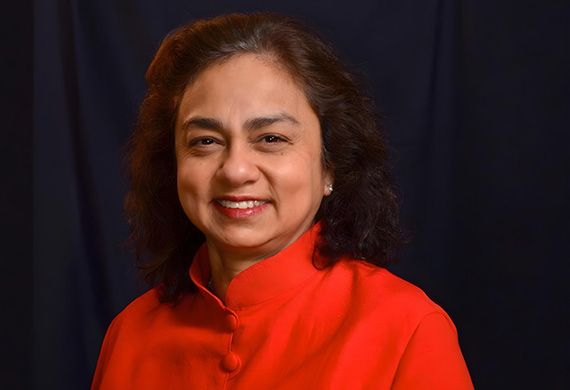
Digital Innovation Driving Low-Cost Solutions for Urban NCDs
By: Dr Nalini Saligram, Founder & CEO, Arogya World
Nalini, a global health advocate with a Ph.D. in biochemistry, combines scientific expertise and corporate leadership experience to champion NCD prevention. Widely recognized for her impact, she advances healthier lives through innovation, partnerships, and advocacy across diverse communities.
In conversation with Women Entrepreneurs Review Magazine, Nalini shares her insights on how the Arogya City model redefines public health by uniting stakeholders for NCD prevention in Bengaluru. She explains how it drives lifestyle-based behaviour change, and leverages digital innovation to scale impactful, low-cost urban health interventions.
How does the Arogya City model redefine city-level public health by mobilizing diverse stakeholders toward measurable NCD prevention goals?
The world’s population is growing at an alarming rate. By 2050, there will be 10 billion people on the planet. Additionally, by 2050, two out of every three people are likely to be living in cities according to a United Nations report,
Cities in India are among the fastest growing in the world.In fact, by 2050 the #1 and #2 spots in the world will be taken by Indian cities Mumbai and Delhi.People move to cities in search of better jobs, better standards of living and to give their children a good leg up in life. It’s a sign and consequence of progress.
It’s not just urban planning, housing, transportation and various public services that are impacted. Public health is also impacted significantly.
In Bangalore for e.g. according to a World Economic Forum white paper, 22% of the people are diabetic, and alarmingly 45% are obese and a staggering 65% are inactive.
We at Arogya World couldn’t sit still. Surely something could be done about this situation. Inaction was not an option.
We came up with a model and decided to go about igniting action and a sense of responsibility among Bangalore’s many forward-thinking stakeholders and got them to do something about the horrendous trend of NCDs and mental health in our city
Arogya City is a program that unites stakeholders including NGOs, corporates, civil society organizations, colleges, start-ups, etc. towards making cities healthier and towards creating lasting impact. People make their pledges voluntarily and in public and are given 2 years to complete their pledges.All along they are encouraged and celebrated for their progress.The effort is sustainable because every pledge is made voluntarily.
Arogya City Bengaluru has achieved a significant milestone through its pledge-based approach with 22 pledgemakers reaching about 1 million citizens in 2022 -2024. This is helping us to turn health into a shared responsibility and making it a priority.
What strategies have proven most effective in turning lifestyle-related health choices into a citywide movement for behaviour change?
At Arogya City, the focus is on making health everyone’s responsibility and keeping it local and actionable. The use of public pledges has proven to be effective as organizations declare their intent publicly so everyone can track their progress. Because the pledges are public, the pledgemakers work verry hard to live up to their promises.
Another reason for its success if that the process of joining Arogya City is simple. We make it easy for different pledgemakers to join hands and take action. And essentially, they can decide to implement a project of their choice that has to do with some aspects of NCD prevention and control. And ideally uses technology.
Some of the efforts are to do with screening and early detection, some to do with prevention i.e. fostering improved eating and increasing physical activity.
Some deal with adolescent health or the health of the elderly, yet others instill lifestyle change through text message campaigns or by educating street food vendors.
Bangalore Pledgemakers like Jaynagar Jaguars and Arogya World’s Run in Red get women and men to move. These are localized actions that help generate awareness and create visible change. Additionally, instead of making health prescriptive, the emphasis is on positioning it as aspirational and voluntary. Reaching out to about 1 million individuals collectively in the first such effort in Bangalore is proof of the efficiency and viability of such strategies.
With your global health background, how do you see local initiatives like Arogya City informing international approaches to NCD prevention?
Arogya City is a scalable, community-led model for NCD prevention and control, driven by local partnerships. What is distinctive about it is that it is action-oriented and is entirely voluntary. Pledgemakers take action because they want to.
As a global health practitioner this is what excites me. Arogya City is not a blueprint from some health authority that is sitting on a shelf. It is actionable and is demonstrably working.
Here is the approach in a nutshell- bring organizations together, get them to do something on a voluntary basis to improve the health of people, make those promises public so everyone delivers on them, measure the impact as best you can, recognize and reward the Pledgemakers and you have a blueprint for collective action even if not every ‘I’ is dotted or ‘t’ crossed.
As NCD prevalence increases globally, particularly in low- and middle-income countries, Arogya City provides a practical, replicable approach to promote health and change health behaviours city-wide.
What role does digital innovation play in scaling low-cost, high-impact interventions, especially in urban and underserved communities?
Digital innovation is a strong force for empowering equitable, scalable health programs, especially for Arogya City. Mobile apps, SMS tools, and WhatsApp-based educational programs facilitate health education and health behavior change messages to be delivered directly to people in limited resource settings. Digital tools can support mass screening, collect data in real-time, track progress over time and at low cost.
With respect to urban slums or rural areas, where often healthcare access is limited for many, telemedicine, mobile health interventions, and AI-based risk assessment tools are being used to narrow the gap.
Digital innovation also brings better agency and reduces health inequities by delivering health information in regional language, or by making culturally relevant adaptations.
In Arogya City Bengaluru, one start up used AI stethoscopes to detect heart murmurs.
Arogya World’s own digital projects, such as the mDiabetes program are examples of using mobile health interventions that have the potential to reach millions. By harnessing digital innovation, while also focusing on community engagement, prevention can be scalable, but most importantly it can be ingrained in people's daily lives.
We are now working with Karnataka government to scale this up statewide. Arogya World’s Healthy School program has been digitized and is being delivered digitally in classrooms and communities around the country. And our MyThali program uses social media to educate women on what to eat and in what quantities at each meal through creative campaigns like #HealthyWaliDiwali. We also encourage women and men to take part in online campaigns. For instance, we have #RuninRed campaign in place aimed at generating awareness around women’s heart health each year.
How can cities worldwide adopt a multisectoral, pledge-based framework to drive sustainable health impact beyond government systems?
Bengaluru in 2022 embarked on a journey to become India’s first Arogya City with its pioneering 22 Pledgemakers. In Dec 2024 the next two-year cycle began.
Now in 2025 the movement is spreading to Mysuru. Additionally, the plan is to take it to Mumbai soon. Indiaspora and CatalystNow have joined us as partners to help this movement grow. What is amazing about this effort is that it is citizen-led, community-based and collaborative.
Many partnerships have been forged between Pledgemakers. This approach shifts the narrative away from a top-down government led mandate. By making every Pledgemaker own the problem, make a public promise to do something about it, and contribute meaningfully to solve it, we all become equal part of the solution as well.
It is really hard to solve a problem as huge as heart disease or diabetes in a country as vast as India. But it is possible to grapple with it in cities. Cities indeed are crucibles of change. And as Arogya Cities show, cities can be really powerful crucibles for tackling NCDs. See the Playbook to serve as a guide for other cities.
Most Viewed
- 1 Women's Health Startup HerMD Closing Doors Amid Industry Challenges
- 2 5 Famous Women in Indian Armed Forces
- 3 Saudi Women No longer Require Male Permission for Clothing Choices, says Prince MbS
- 4 Kolkata Medtech Startup Innovodigm Raises Rs 5.5 Crore Seed Funding Led by IAN Group
- 5 Yamunanagar's Kashish Kalra Honoured after Securing 111th Rank in UPSC Civil Services Exam
- 6 Madurai Appoints Its First Woman Corporation Head
- 7 IAS Vijayalakshmi Bidari Appointed as the new Nagpur Divisional Commissioner
- 8 American Entrepreneur Lucy Guo Overtakes T Swift to become Youngest Female Billionaire
- 9 ICC Women's World Cup 2025 Trophy Showcased at Indore's Holkar Stadium
- 10 Aparna Saxena's Beauty Venture AntiNorm Launches in India
- 11 Vidya Nataraj Co-Founded BlueStone Jewellery & Lifestyle files IPO
- 12 5 Women Freedom Fighters of India
- 13 Dr. G Krishnapriya appointed as CEO for Trichy
- 14 M3M & Sirona Partner to Introduce Menstrual Hygiene Vending Machines in 15 Locations
- 15 Punjab Govt launches SHE Cohort 3.0 Supporting Tech-led Women Startups
- 16 Indian origin Lawyer, Sweena Pannu appointed as the US New Superior Court Judge
- 17 The Aurora Tech Award recognizes 4 Indian Women-led Startups
- 18 Kerala's Republic Day parade featured an all-female tableau
- 19 Manisha Kabbur Becomes Karnataka's First Woman International Karate Coach
- 20 Director K. S. Ravikumar's Daughter Maalica Ravikumar Launches Life Coaching Company 'Evergrowth Academy' for Women
- 21 Leezu's Raises Pre-Seed Funding to Accelerate Growth in Sexual Wellness Industry
- 22 Sattu: Super-easy summer drink for PCOS gut healing
- 23 Swathi Nelabhatla creates Sitha App, India's First Women-Exclusive Gig Platform
- 24 7 Timeless Female Kathak Dancers & their Iconic Legacies
- 25 Meet 7 Iconic Women Architects of Modern India & their Most Impactful Work
- 26 This Woman-led Insuretech Startup is Helping Bridge the Education Financing Gap in India
- 27 Women Leaders Share Lessons Learnt from India Women's WC Win
- 28 5 Enterprising Women Founders Powering Singapore's Tech & Innovation Landscape
- 29 4 Women. 4 Stories. One Vision for Smarter, Stronger Healthcare
- 30 Global Gender Gap Narrows to 68.8%, But Full Equality 123 Years Away: WEF Report 2025
- 31 Changemakers: 7 Women Entrepreneurs Taking the Make in India Movement Forward
- 32 Meet Lucy Guo, The Youngest Self-Made Female Billionaire Disrupting Tech
- 33 How Women are Driving India's Festive Online Shopping Surge






